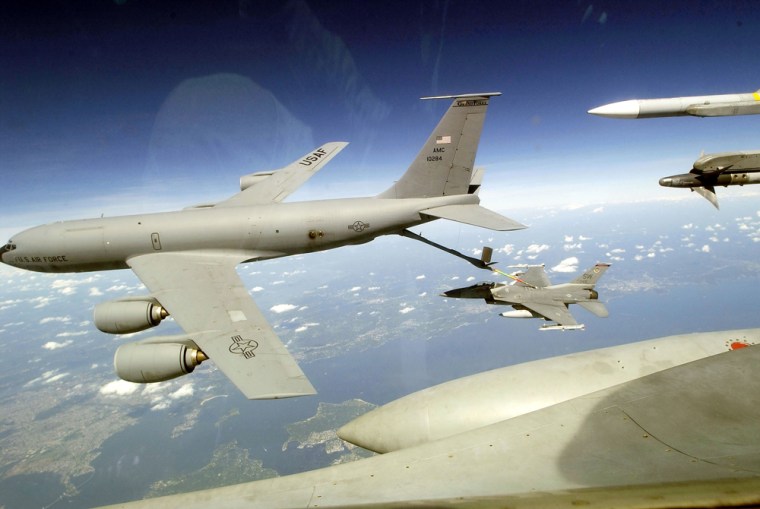The commander of military forces protecting North America has ordered a review of the costly air defenses intended to prevent another Sept. 11-style terrorism attack, an assessment aimed at determining whether the commitment of jet fighters, other aircraft and crews remains justified.
Senior officers involved in the effort say the assessment is to gauge the likelihood that terrorists may succeed in hijacking an airliner or flying their own smaller craft into the United States or Canada. The study is focused on circumstances in which the attack would be aimed not at a public building or landmark but instead at a power plant or a critical link in the nation’s financial network, like a major electrical grid or a computer network hub.
The review, to be completed next spring, is expected to be the military’s most thorough reassessment of the threat of a terrorism attack by air since Al Qaeda’s strikes on Sept. 11, 2001, transformed a Defense Department focused on fighting other militaries and led to the Bush administration’s “global war on terror.”
The assessment is partly a reflection of how a military straining to fight two wars is questioning whether it makes sense to keep in place the costly system of protections established after those attacks on the World Trade Center and the Pentagon. Though combat patrols above American cities were discontinued in 2007, the military keeps dozens of warplanes and hundreds of air crew members on alert to respond to potential threats.
“The fighter force is extremely expensive, so you always have to ask yourself the question ‘How much is enough?’ ” said Maj. Gen. Pierre J. Forgues of Canada, director of operations for the North American Aerospace Defense Command, or Norad, which carries out the air defense mission within the United States military’s Northern Command.
Safer today?
Northern Command, based here in Colorado Springs, will try to determine in its review whether the United States is safer today. Military strategists and operations officers have been asked to address whether the security measures put in place since 2001 have diminished the threat of terrorist attack by aircraft to such an extent that a smaller commitment of combat jets and personnel is now warranted.
Officers conducting the review said that a number of security steps adopted in the last eight years should be factored into whether to sustain the air defense mission at current levels. Among those steps are screening measures at airports; the addition of armored, locked cockpit doors on commercial planes; much tighter restrictions on airspace around Washington; and a host of law enforcement and intelligence operations to identify and track potential terrorists and prevent them from boarding airliners.
“The ability of terrorists to do what they did on 9/11 has been greatly curtailed,” General Forgues said in an interview at his headquarters here. “But, as has been said, we would be concerned by the lack of imagination. And so we do not want to view the defense posture strictly in terms of threat. We want to view the defense posture in terms of vulnerability as well.”
He said the assessment would look at schemes different from those carried out by the Sept. 11 hijackers and would include reviewing the vulnerability of the nation’s communications infrastructure, power generation and distributions networks, and financial infrastructure to a kamikaze-style attack.
Gen. Victor E. Renuart Jr., the head of Northern Command, ordered the review in response to criticism this year by the Government Accountability Office that the command had failed to conduct “routine risk assessments.” General Renuart expanded the scope of the review “to refine how we allocate and request resources today,” said the command’s spokesman, James Graybeal.
The exact number of warplanes assigned to defending American territory, and the bases where they remain on alert, are classified. But while the Defense Department has acknowledged some past changes in the mission, as when it eliminated 24-hour combat air patrols over New York and Washington in 2002, senior officers say the resources committed to the mission and the alert posture for fighter jets and pilots have not changed since the 2001 attacks.
General Forgues said the American and Canadian fleets of jet fighters, refueling tankers and radar planes “are always in high demand and low supply.”
“Now more than ever,” he said of the current extra stress on the force, “is the need to rationalize what we’re doing and what we’re investing in those areas.”
General Forgues cautioned that there was no predetermined outcome of the review and that it was possible the commitment to the air defense mission would remain the same, or even increase.
Statistics provided by Norad show that in 2008, there were more than 1,000 instances of suspicious air activity. Of those, about 400 required a response from Norad, ranging from putting crews on higher ground alert to actually scrambling jet fighters, which were sent aloft in more than 200 of those incidents.
The combat air patrols over American cities are now used only for drills and for special events like presidential inaugurations and the Super Bowl. But at their peak in the aftermath of Sept. 11, the missions cost $50 million a week and required the assignment of about 11,000 Air Force personnel and 250 planes: fighters, refueling tankers and airborne radar.
By comparison, no more than 14 planes at seven bases had been on alert before those attacks to defend American territory from what had been an increasingly unlikely prospect: a strike by Russian warplanes.
This article, , first was published in The New York Times.
